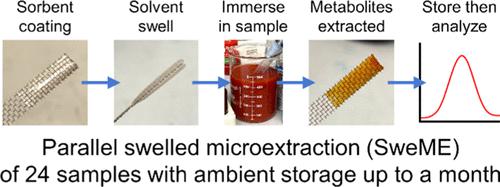当前位置:
X-MOL 学术
›
J. Agric. Food Chem.
›
论文详情
Our official English website, www.x-mol.net, welcomes your feedback! (Note: you will need to create a separate account there.)
Swellable Sorbent Coatings for Parallel Extraction, Storage, and Analysis of Plant Metabolites
Journal of Agricultural and Food Chemistry ( IF 6.1 ) Pub Date : 2022-06-14 , DOI: 10.1021/acs.jafc.2c01676 Jessica P Rafson 1 , Gavin L Sacks 1
Journal of Agricultural and Food Chemistry ( IF 6.1 ) Pub Date : 2022-06-14 , DOI: 10.1021/acs.jafc.2c01676 Jessica P Rafson 1 , Gavin L Sacks 1
Affiliation

|
Quantitative and qualitative measurements of trace-level analytes in plants or foodstuffs, e.g., secondary metabolites like carotenoids, are often performed at centralized core facilities or off-site laboratories. However, preparation, storage, and/or transport of both intact samples and sample extracts may be cumbersome and complicated, especially for air-sensitive analytes. We describe the development of inexpensive swellable microextraction (SweME) devices for extraction and storage of nonpolar analytes. SweME devices consist of a thin layer of poly(dimethylsiloxane) (PDMS) grafted onto a stainless steel support. Pretreating the SweME device with small volumes of the organic solvent causes the PDMS to swell. The swollen SweME device can then be immersed directly into complex matrices for absorptive extraction of low-molecular-weight, nonpolar analytes. Following storage, analytes can be solvent-desorbed prior to characterization. Proof-of-principle work with carotenoids from tomatoes and carrots demonstrates that SweME is appropriate for semiquantitative analyses and increases the stability of air-sensitive analytes during storage at ambient temperatures as compared to the solvent extracts. Carotenoid profiles (fractional carotenoid contributions) from tomato and carrot samples were well correlated between SweME and liquid–liquid extraction (R2 = 0.97 and 0.94). Lycopene, the most abundant carotenoid in tomatoes, saw a less than 20% decrease in extracted mass during 1 month of ambient SweME storage. Extractions and desorptions can be run in parallel using multiwell plates. In summary, swelled sorbent extraction with SweME devices is a convenient and inexpensive approach for isolation and storage of analytes in complex matrices and may be particularly well suited for evaluating large numbers of plant samples through external laboratories.
中文翻译:

用于植物代谢物平行提取、储存和分析的可溶胀吸附剂涂层
植物或食品中痕量分析物(例如类胡萝卜素等次生代谢物)的定量和定性测量通常在集中式核心设施或异地实验室进行。然而,完整样品和样品提取物的制备、储存和/或运输可能既麻烦又复杂,尤其是对空气敏感的分析物。我们描述了用于提取和储存非极性分析物的廉价可膨胀微萃取 (SweME) 装置的开发。SweME 装置由一层薄薄的聚 (二甲基硅氧烷) (PDMS) 接枝到不锈钢支架上。用少量有机溶剂预处理 SweME 装置会导致 PDMS 膨胀。然后可以将膨胀的 SweME 装置直接浸入复杂的基质中,以吸收提取低分子量、非极性分析物。储存后,分析物可以在表征之前进行溶剂解吸。对来自西红柿和胡萝卜的类胡萝卜素的原理验证工作表明,与溶剂提取物相比,SweME 适用于半定量分析,并提高了在环境温度下储存期间对空气敏感的分析物的稳定性。来自番茄和胡萝卜样品的类胡萝卜素谱(部分类胡萝卜素贡献)在 SweME 和液液萃取之间具有很好的相关性(对来自西红柿和胡萝卜的类胡萝卜素的原理验证工作表明,与溶剂提取物相比,SweME 适用于半定量分析,并提高了在环境温度下储存期间对空气敏感的分析物的稳定性。来自番茄和胡萝卜样品的类胡萝卜素谱(部分类胡萝卜素贡献)在 SweME 和液液萃取之间具有很好的相关性(对来自西红柿和胡萝卜的类胡萝卜素的原理验证工作表明,与溶剂提取物相比,SweME 适用于半定量分析,并提高了在环境温度下储存期间对空气敏感的分析物的稳定性。来自番茄和胡萝卜样品的类胡萝卜素谱(部分类胡萝卜素贡献)在 SweME 和液液萃取之间具有很好的相关性(R 2 = 0.97 和 0.94)。番茄红素是番茄中含量最丰富的类胡萝卜素,在环境 SweME 储存 1 个月期间,提取的质量减少了不到 20%。提取和解吸可以使用多孔板并行运行。总之,使用 SweME 设备进行溶胀吸附剂萃取是一种方便且廉价的方法,用于分离和储存复杂基质中的分析物,并且可能特别适合通过外部实验室评估大量植物样品。
更新日期:2022-06-14
中文翻译:

用于植物代谢物平行提取、储存和分析的可溶胀吸附剂涂层
植物或食品中痕量分析物(例如类胡萝卜素等次生代谢物)的定量和定性测量通常在集中式核心设施或异地实验室进行。然而,完整样品和样品提取物的制备、储存和/或运输可能既麻烦又复杂,尤其是对空气敏感的分析物。我们描述了用于提取和储存非极性分析物的廉价可膨胀微萃取 (SweME) 装置的开发。SweME 装置由一层薄薄的聚 (二甲基硅氧烷) (PDMS) 接枝到不锈钢支架上。用少量有机溶剂预处理 SweME 装置会导致 PDMS 膨胀。然后可以将膨胀的 SweME 装置直接浸入复杂的基质中,以吸收提取低分子量、非极性分析物。储存后,分析物可以在表征之前进行溶剂解吸。对来自西红柿和胡萝卜的类胡萝卜素的原理验证工作表明,与溶剂提取物相比,SweME 适用于半定量分析,并提高了在环境温度下储存期间对空气敏感的分析物的稳定性。来自番茄和胡萝卜样品的类胡萝卜素谱(部分类胡萝卜素贡献)在 SweME 和液液萃取之间具有很好的相关性(对来自西红柿和胡萝卜的类胡萝卜素的原理验证工作表明,与溶剂提取物相比,SweME 适用于半定量分析,并提高了在环境温度下储存期间对空气敏感的分析物的稳定性。来自番茄和胡萝卜样品的类胡萝卜素谱(部分类胡萝卜素贡献)在 SweME 和液液萃取之间具有很好的相关性(对来自西红柿和胡萝卜的类胡萝卜素的原理验证工作表明,与溶剂提取物相比,SweME 适用于半定量分析,并提高了在环境温度下储存期间对空气敏感的分析物的稳定性。来自番茄和胡萝卜样品的类胡萝卜素谱(部分类胡萝卜素贡献)在 SweME 和液液萃取之间具有很好的相关性(R 2 = 0.97 和 0.94)。番茄红素是番茄中含量最丰富的类胡萝卜素,在环境 SweME 储存 1 个月期间,提取的质量减少了不到 20%。提取和解吸可以使用多孔板并行运行。总之,使用 SweME 设备进行溶胀吸附剂萃取是一种方便且廉价的方法,用于分离和储存复杂基质中的分析物,并且可能特别适合通过外部实验室评估大量植物样品。



























 京公网安备 11010802027423号
京公网安备 11010802027423号